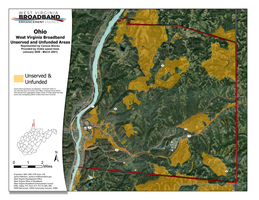 | Back to e-WV
| Back to e-WV
 The West Virginia Encyclopedia
The West Virginia Encyclopedia
 | Back to e-WV
| Back to e-WV
 The West Virginia Encyclopedia
The West Virginia Encyclopedia

West Virginians accessed the Internet in the late 1980s by connecting a computer with a modem to a phone line and dialing up a service provider such as America Online, Prodigy, or CompuServe. Information was limited to whatever the provider offered, and the subscriber paid either by the hour for access or a monthly subscription fee. Businesses could lease a dedicated line from the phone company, but it was expensive.
The Internet became faster with the use of signals of greater bandwidth, which became known as broadband. By 1994, broadband was spreading in the state. Bell Atlantic, then the state’s largest telecommunications provider, launched its World School program and, within three years, connected 700 schools in the state to the Internet. Meanwhile, as more resources on the Internet became freely available, consumer dial-up service providers emerged from within the state. CityNet launched in Charleston in November 1994. MarCom emerged in Bridgeport and MountainNet in Morgantown. In 1995 a local dial-up number in the Kanawha Valley and unlimited Internet time cost $25 a month.
Internet content developed within West Virginia also grew during this period. State government launched its home page on June 15, 1996, with links to five state agencies. The Charleston Gazette, Charleston Daily Mail, Morgantown Dominion Post, and Fairmont Times West Virginian went online in 1996; the Huntington Herald-Dispatch went online in mid-1997.
By late 1998 the state government’s website had links to more than 60 agencies and was receiving three million hits a month. The Internet was changing the way West Virginians did business. For example, McCabe-Henley Properties, a Charleston-based commercial real estate company, began to use the Internet to collaborate with companies in West Virginia, Hawaii, Virginia, and Texas.
More than 20 Internet service providers were listed in the 2000 Charleston telephone book; most offered dial-up service for $14.95 to $16.95 a month. Verizon, the successor to Bell Atlantic, launched a 760-kilobits-per-second Internet service called Digital Subscriber Line, or DSL, in Charleston in March 2000. Like dial-up service, DSL service relied on phone lines, but it allowed the customer to use their phone and computer at the same time without the computer tying up the phone. Artist Rick Lee and lawyer Harry Bell were Verizon’s first customers for DSL.
Charter Communications (later Suddenlink, now Optimum), the state’s largest cable provider, launched cable Internet service in Parkersburg in June 2000, Charleston in August 2000, Beckley in September 2000, and the Logan-Kermit market in December 2001. StarBand Communications offered two-way satellite Internet access, for customers with neither DSL nor cable internet available, for a $299 equipment installation fee and $59.95 a month. But most rural residents still waited for access to the Internet. Landline telephone companies had to upgrade their central offices before they could offer DSL.
Internet competition increased with the arrival of the upstart FiberNet (now Lumos). Suddenlink and Comcast offered broadband access speeds of up to six megabits per second. In 2006, the city of Philippi deployed its own fiber network with speeds of up to 100 megabits for Internet and television.
In 2006, for the first time, more West Virginia households accessed the Internet using broadband than a dial-up service. In 2007, 77 percent of West Virginia households had access to high-speed Internet service, but only 59 percent had a computer, and only 34.6 percent subscribed to broadband. Governor Joe Manchin set a goal that by 2010 all West Virginians would have the opportunity to use broadband at home and at work.
The state received a $126.4 million federal stimulus grant in 2010 to deploy more broadband. In July 2010 Frontier Communications bought Verizon’s West Virginia landlines, promising to extend broadband availability. From July 2010 to December 31, 2011, Frontier said it had made broadband available to an additional 108,000 households, pushing availability in the areas Frontier acquired from Verizon to 79.4 percent.
The development of high-tech cell phones gave West Virginians another way to access the Internet. Cellular providers Verizon Wireless, AT&T, Sprint, and nTelos, were among the companies offering service in West Virginia in 2012. Over the next several years, carriers rolled out faster 4G LTE networks, allowing smartphones to use web browsers and access email.
In 2020, cellular provider T-Mobile merged with Sprint, leaving T-Mobile, AT&T, and Verizon as the major wireless carriers in the state and in the country. By 2022, faster 5G networks were available in much of the country and in parts of West Virginia; however, rural parts of the state still lacked both high-speed wired broadband and 5G wireless access. Nearly 20 percent of the state could not purchase an Internet plan with at least 25 Mbps (megabits per second) download speeds. West Virginia ranked 44th in the nation in Internet connectivity. While 71 percent of the state had access to high-speed service (at least 100/20 Mbps), it varied greatly based on location. Cities had greater access, but most rural areas lagged far behind. High-speed service was limited to four percent of serviceable areas in Calhoun County and nine percent in Clay County. Only about 100,000 West Virginians (5.2 percent) have fiber-optic access, the worst rate in the nation. Only 65.8 percent of West Virginians have access to broadband, with an average download speed of 51.3 MBs per second.
In June 2023, government officials announced that West Virginia would receive $1.2 billion in federal funds for high-speed Internet infrastructure deployment, as part of the Infrastructure Investment and Jobs Act. Commercial Internet providers must meet specific service benchmarks, based on a five-year action plan, to receive funding from this program.
Written by George Hohmann
West Virginia Internet Coverage & Availability in 2022. BroadbandNow
McElhinny, Brad. Historic internet opportunity will roll out with safeguards over a period of years, West Virginia officials say. WV Metro News, June 28, 2023.